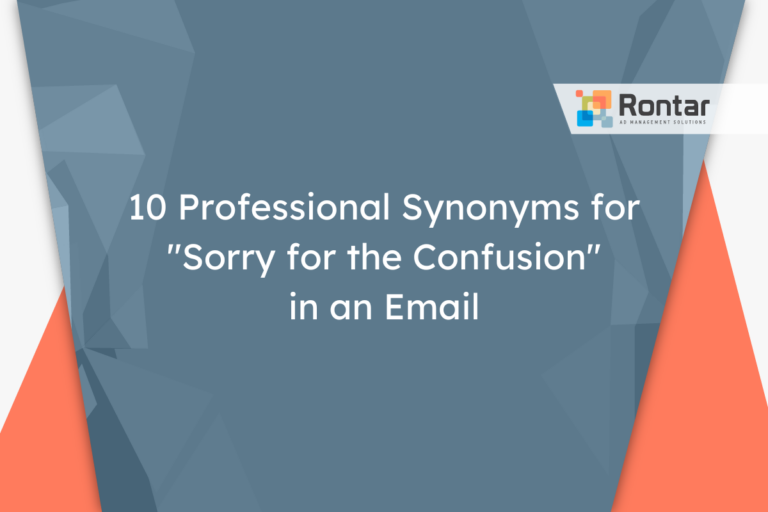10 Professional Ways to Say “I Am Writing to Let You Know” in an Email

In professional settings, how we start an email matters a lot. Using the phrase “I am writing to let you know” is common, but sometimes we need variety to match different situations or tones.
This article lists ten professional alternatives to this phrase, providing examples and tips on when to use them.
Is It Professional to Say “I Am Writing to Let You Know”?
The phrase “I am writing to let you know” is often seen as both professional and polite. It is more on the formal side of language use and is commonly accepted in business correspondence. This phrase is straightforward and respectful, making it a good fit for many situations where you need to convey information or updates.
It works well with various types of recipients, including colleagues, bosses, clients, and other professionals. It’s particularly useful in emails, where the tone can easily be misinterpreted without clear and respectful language.
Here’s a short example:
Dear Alexandra,
I am writing to let you know that the meeting scheduled for tomorrow has been postponed to next Friday, the 24th, due to unexpected circumstances.
Thank you for your understanding.
Best regards,
Marcus
Pros:
- Ensures clarity and reduces misunderstandings in communication.
- Conveys respect and professionalism.
- Appropriate for a diverse range of professional settings and recipients.
Cons:
- Can feel overly formal in less traditional or more casual workplaces.
- Might be considered redundant since the act of writing is already a way of letting someone know something.
While “I am writing to let you know” is effective, someone might consider using an alternative phrase in certain contexts. This could be to avoid redundancy or to adapt the tone to match a more casual or innovative workplace culture.
10 Other Ways to Say “I Am Writing to Let You Know” in an Email
Here are some professional alternatives to the common phrase “I am writing to let you know” that you can use in the workplace:
- I wanted to update you on
- I need to inform you about
- Just reaching out to share
- Wanted to bring to your attention
- I’m contacting you to discuss
- Please be advised that
- It’s important to notify you that
- I feel it’s necessary to mention
- I’m pleased to let you know
- Allow me to highlight
1. I wanted to update you on
This alternative is more informal and conversational compared to the original, yet it remains professional and polite. It suggests a degree of prior knowledge or involvement with the topic by the recipient, making it ideal for ongoing projects or updates within a team.
This phrase is particularly suited for emails to colleagues or team members who are directly involved in the subject matter. It can help in creating a friendly yet professional tone in the workplace. It is less formal, making it a great choice for most modern, collaborative work environments.
Example:
Dear Tyler,
I wanted to update you on the project timeline. It looks like we're going to meet our deadline with no issues.
Best,
Ava
2. I need to inform you about
This phrase is slightly more formal than the original and implies the importance of the message. It’s professional and gets straight to the point, making it suitable when delivering significant updates or information that requires immediate attention.
It works best in communications with both superiors and colleagues, especially when discussing matters that impact company operations or individual responsibilities. This option is ideal for emails where the information is crucial and may affect the recipient’s tasks or plans.
Example:
Dear Mr. Jenkins,
I need to inform you about a change in the client's requirements that affects our current strategy.
Regards,
Sophia
This alternative is much more informal than the original phrase, promoting a casual and approachable tone. It’s still professional but adds a personal touch to the message. This phrasing is excellent for fostering friendly relationships within the workplace.
Best suited for emails to colleagues or clients with whom you have an established rapport. It’s particularly effective in less formal industries or company cultures where maintaining a light atmosphere is encouraged. Not recommended for very formal communications or with new contacts.
Example:
Hey Jordan,
Just reaching out to share some exciting news about our project's progress.
Cheers,
Mia
4. Wanted to bring to your attention
This phrase is a gentle way of highlighting something important without being too direct or formal. It’s professional and polite, providing a subtle nudge to the recipient about the significance of the message.
This alternative is ideal for situations where you need to raise an issue or concern without coming across as too commanding or authoritative. It works well with both peers and higher-ups, striking a balance between formality and approachability.
Example:
Dear Team,
Wanted to bring to your attention the updated safety protocols that need to be implemented immediately.
Best regards,
Carlos
5. I’m contacting you to discuss
This alternative conveys a purposeful intention to engage in more detailed communication. It’s professional and suggests that the email will lead to further discussion, either through emails or in meetings. This phrase is to the point while also inviting engagement from the recipient.
Especially suitable when seeking to start a conversation on specific issues, projects, or decisions with colleagues, clients, or management. It sets the stage for an in-depth exchange of ideas and is best used in professional settings where collaboration is key.
Example:
Dear Lauren,
I'm contacting you to discuss the feedback we received on our recent project submission.
Kind regards,
Evan
6. Please be advised that
This option is more formal and is typically used to convey instructions or important notices. While still professional, its formality gives it an official tone that commands attention. It’s very polite and appropriate for conveying messages that may have legal, financial, or safety implications.
Best suited for emails to a broad audience within an organization or to individuals where clarity and formality are paramount. It’s often used for official announcements, policy updates, or when providing critical instructions.
Example:
All Employees,
Please be advised that the office will be closed next Monday for maintenance.
Sincerely,
Janet
7. It’s important to notify you that
This alternative is formal and emphasizes the significance of the information being shared. It is professional and polite, making it clear that the recipient needs to pay attention to the contents of the email.
It is particularly effective when delivering information that could impact the recipient’s work or schedule. Ideal for use with both superiors and colleagues, especially in more traditional or formal corporate environments where conveying the importance of a message is critical.
Example:
Dear Department Heads,
It's important to notify you that budget reviews will be moving up to next week.
Regards,
Fiona
8. I feel it’s necessary to mention
This phrase adds a personal touch to the message, indicating that the sender has given some thought to the information being communicated. It’s professional yet slightly more informal than some of the other alternatives, adding a layer of sincerity to the communication.
Suitable when you wish to share observations, concerns, or recommendations that stem from personal insight or experience. Ideal for messages to team members, project leaders, or even clients when you’re invested in the outcome of the discussed matter.
Example:
Hi Rebecca,
I feel it's necessary to mention that the current project timeline might be a bit optimistic based on our resources.
Best,
Liam
9. I’m pleased to let you know
This phrase is informal and conveys a positive tone. It’s professional while also sharing good news or positive updates in an enthusiastic manner. It adds a warm and personal touch to workplace communications.
This alternative is perfect for congratulatory messages, successful project completions, or other positive updates. It works great with all types of recipients, from colleagues to clients, especially in environments that value a positive company culture.
Example:
Team,
I'm pleased to let you know that we've exceeded our quarterly goals!
Warmest regards,
Nina
10. Allow me to highlight
This phrase offers a way to draw attention to specific information or accomplishments with a sense of formality and importance. It’s professional and polite, making it effective for emphasizing key points in a message.
Particularly useful for reports, presentations, or email updates where it’s essential to ensure that certain information stands out. Ideal for communication with superiors or colleagues in a professional context where highlighting achievements or critical data is necessary.
Example:
Dear Stakeholders,
Allow me to highlight the major milestones we've achieved in the last quarter.
Sincerely,
Oliver
Final Thoughts
Choosing the right way to start your professional email sets the tone for the entire message. The alternatives provided in this article aim to help you communicate more clearly and effectively, using phrases that match the situation’s formality and your relationship with the recipient. Using these options can make your emails feel more personalized and engaging.






